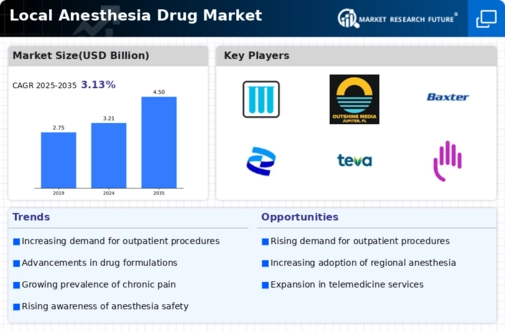Market Growth Projections
The Global Local Anesthesia Drug Market Industry is poised for substantial growth, with projections indicating a market value of 3.21 USD Billion in 2024 and an anticipated increase to 4.5 USD Billion by 2035. This growth trajectory reflects a compound annual growth rate (CAGR) of 3.12% from 2025 to 2035. Such figures suggest a robust demand for local anesthetic agents driven by various factors, including the rising number of surgical and dental procedures, advancements in anesthesia technology, and an increasing focus on effective pain management strategies. The market's expansion is likely to create opportunities for stakeholders across the healthcare spectrum.
Expansion of Dental Procedures
The expansion of dental procedures significantly impacts the Global Local Anesthesia Drug Market Industry. With an increasing focus on oral health and aesthetics, more individuals seek dental treatments, ranging from routine check-ups to complex surgeries. Local anesthesia plays a crucial role in these procedures, ensuring patient comfort and minimizing pain. As dental practices continue to grow and evolve, the demand for effective local anesthetic agents is likely to rise. This trend is expected to contribute to the overall market growth, aligning with the projected increase in market value to 4.5 USD Billion by 2035, as dental professionals increasingly rely on local anesthesia to enhance patient experiences.
Rising Demand for Surgical Procedures
The Global Local Anesthesia Drug Market Industry experiences a notable surge in demand due to the increasing number of surgical procedures performed worldwide. As healthcare systems evolve and expand, the volume of surgeries, including elective and emergency operations, continues to rise. This trend is particularly evident in regions with aging populations, where surgical interventions become more prevalent. In 2024, the market is projected to reach 3.21 USD Billion, reflecting the growing reliance on local anesthesia to ensure patient comfort and safety during these procedures. Consequently, the demand for local anesthetic agents is expected to grow, contributing to the overall market expansion.
Increasing Awareness of Pain Management
The Global Local Anesthesia Drug Market Industry benefits from a growing awareness of pain management strategies among both healthcare professionals and patients. As the understanding of pain control evolves, there is a greater emphasis on utilizing local anesthesia as a means to enhance patient comfort during various medical procedures. This shift in perspective encourages healthcare providers to adopt local anesthetic techniques more widely, thereby increasing their usage. The market's growth trajectory, with a projected CAGR of 3.12% from 2025 to 2035, indicates that the emphasis on effective pain management will continue to drive demand for local anesthetic agents.
Regulatory Support for Anesthetic Agents
Regulatory bodies play a pivotal role in shaping the Global Local Anesthesia Drug Market Industry by establishing guidelines and standards for the use of anesthetic agents. Supportive regulations facilitate the approval and availability of new local anesthetics, ensuring that healthcare providers have access to safe and effective options. This regulatory environment encourages innovation and the development of novel anesthetic formulations, which can enhance patient care. As the market continues to evolve, the influence of regulatory frameworks will likely drive growth, fostering a landscape where local anesthesia remains a cornerstone of modern medical practice.
Technological Advancements in Anesthesia Delivery
Technological innovations in anesthesia delivery systems significantly influence the Global Local Anesthesia Drug Market Industry. The introduction of advanced devices, such as computer-controlled local anesthetic delivery systems, enhances precision and reduces the risk of complications. These advancements not only improve patient outcomes but also streamline the administration process for healthcare providers. As a result, the adoption of these technologies is likely to increase, driving market growth. The anticipated growth in the market, projected to reach 4.5 USD Billion by 2035, underscores the importance of integrating technology into local anesthesia practices to meet evolving healthcare demands.
















